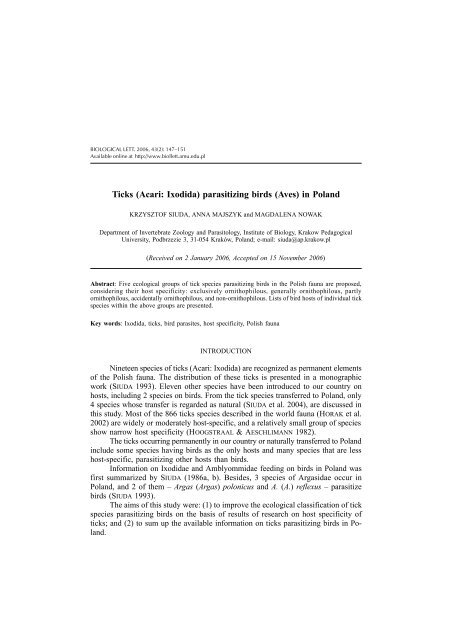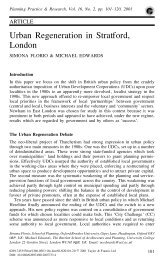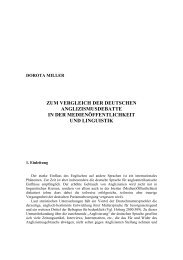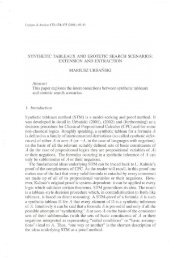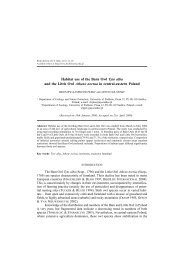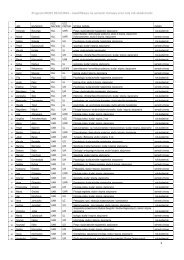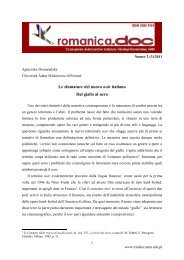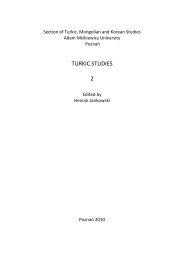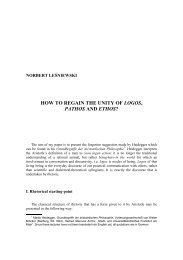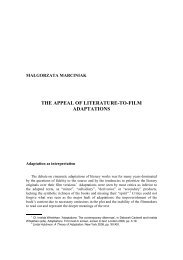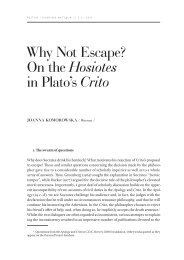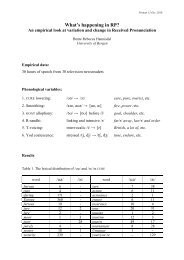Ticks (Acari: Ixodida) parasitizing birds (Aves) in Poland
Ticks (Acari: Ixodida) parasitizing birds (Aves) in Poland
Ticks (Acari: Ixodida) parasitizing birds (Aves) in Poland
Create successful ePaper yourself
Turn your PDF publications into a flip-book with our unique Google optimized e-Paper software.
TICKS PARASITIZING BIRDS IN POLAND147BIOLOGICAL LETT. 2006, 43(2): 147–151Available onl<strong>in</strong>e at http://www.biollett.amu.edu.pl<strong>Ticks</strong> (<strong>Acari</strong>: <strong>Ixodida</strong>) <strong>parasitiz<strong>in</strong>g</strong> <strong>birds</strong> (<strong>Aves</strong>) <strong>in</strong> <strong>Poland</strong>KRZYSZTOF SIUDA, ANNA MAJSZYK and MAGDALENA NOWAKDepartment of Invertebrate Zoology and Parasitology, Institute of Biology, Krakow PedagogicalUniversity, Podbrzezie 3, 31-054 Kraków, <strong>Poland</strong>; e-mail: siuda@ap.krakow.pl(Received on 2 January 2006, Accepted on 15 November 2006)Abstract: Five ecological groups of tick species <strong>parasitiz<strong>in</strong>g</strong> <strong>birds</strong> <strong>in</strong> the Polish fauna are proposed,consider<strong>in</strong>g their host specificity: exclusively ornithophilous, generally ornithophilous, partlyornithophilous, accidentally ornithophilous, and non-ornithophilous. Lists of bird hosts of <strong>in</strong>dividual tickspecies with<strong>in</strong> the above groups are presented.Key words: <strong>Ixodida</strong>, ticks, bird parasites, host specificity, Polish faunaINTRODUCTIONN<strong>in</strong>eteen species of ticks (<strong>Acari</strong>: <strong>Ixodida</strong>) are recognized as permanent elementsof the Polish fauna. The distribution of these ticks is presented <strong>in</strong> a monographicwork (SIUDA 1993). Eleven other species have been <strong>in</strong>troduced to our country onhosts, <strong>in</strong>clud<strong>in</strong>g 2 species on <strong>birds</strong>. From the tick species transferred to <strong>Poland</strong>, only4 species whose transfer is regarded as natural (SIUDA et al. 2004), are discussed <strong>in</strong>this study. Most of the 866 ticks species described <strong>in</strong> the world fauna (HORAK et al.2002) are widely or moderately host-specific, and a relatively small group of speciesshow narrow host specificity (HOOGSTRAAL & AESCHLIMANN 1982).The ticks occurr<strong>in</strong>g permanently <strong>in</strong> our country or naturally transferred to <strong>Poland</strong><strong>in</strong>clude some species hav<strong>in</strong>g <strong>birds</strong> as the only hosts and many species that are lesshost-specific, <strong>parasitiz<strong>in</strong>g</strong> other hosts than <strong>birds</strong>.Information on <strong>Ixodida</strong>e and Amblyommidae feed<strong>in</strong>g on <strong>birds</strong> <strong>in</strong> <strong>Poland</strong> wasfirst summarized by SIUDA (1986a, b). Besides, 3 species of Argasidae occur <strong>in</strong><strong>Poland</strong>, and 2 of them – Argas (Argas) polonicus and A. (A.) reflexus – parasitize<strong>birds</strong> (SIUDA 1993).The aims of this study were: (1) to improve the ecological classification of tickspecies <strong>parasitiz<strong>in</strong>g</strong> <strong>birds</strong> on the basis of results of research on host specificity ofticks; and (2) to sum up the available <strong>in</strong>formation on ticks <strong>parasitiz<strong>in</strong>g</strong> <strong>birds</strong> <strong>in</strong> <strong>Poland</strong>.
148 K. Siuda, A. Majszyk and M. NowakMATERIALS AND METHODSData from own research and from works of other authors on ticks <strong>parasitiz<strong>in</strong>g</strong><strong>birds</strong> <strong>in</strong> <strong>Poland</strong> and published until the end of 2004 were analysed (JAROCKI 1825,SCHULZE & SCHLOTTKE 1929, LEHNERT 1933, SCHULZE 1933, RAFALSKI 1953, 1956,LACHMAJER et al. 1956, EMCHUK 1960, KOLPY 1963, KOZ£OWSKI et al. 1964, LACH-MAJER 1967, 1977, PATAN 1969, GRZYWIÑSKI 1970, KAHL 1971, GRZYBEK et al.1973, GRZYWACZ & KU MICKI 1973, WEGNER 1973, ¯UKOWSKI & BITKOWSKA 1973,FILIPPOVA 1977, 1997, KACZMAREK 1977, 1982a, b, 1988, NOSEK & FOLK 1977,SIUDA & DUTKIEWICZ 1979, SIUDA et al. 1979, 1982, KOLONIN 1983, SIUDA 1984,1985, 1986a, b, 1991, 1993, HAITLINGER 1987, BUCZEK 1991, SIUDA & SZYMAÑSKI1991, BUCZEK & SOLARZ 1993). Moreover, some reports from outside <strong>Poland</strong> wereused (EMCHUK 1960, NOSEK & FOLK 1977, FILIPPOVA 1977, 1997, KOLONIN 1983).RESULTSOn the basis of the analysed data, we propose a new division of tick species ofthe Polish fauna accord<strong>in</strong>g to their host specificity when <strong>parasitiz<strong>in</strong>g</strong> <strong>birds</strong>:1. Exclusively ornithophilous ticks (with very narrow host specificity and <strong>parasitiz<strong>in</strong>g</strong><strong>birds</strong> only): Ixodes (Pholeoixodes) arboricola Schulze et Schlottke, 1929,Ixodes (Pholeoixodes) lividus Koch, 1844, Ixodes (Scaphixodes) caledonicus Nuttall,1910, Ixodes (Trichotoixodes) frontalis (Panzer, 1798).2. Generally ornithophilous ticks (<strong>in</strong>habit<strong>in</strong>g <strong>birds</strong> as their ma<strong>in</strong> hosts, butsometimes attack<strong>in</strong>g other vertebrates): Argas (Argas) polonicus Siuda, Hoogstraal,Clifford et Wassef, 1979, Argas (Argas) reflexus (Fabricius, 1794), Ixodes (Ixodes)festai Rondelli, 1926. The last species is not native to <strong>Poland</strong> (SIUDA 1993).3. Partly ornithophilous ticks (immature stages <strong>parasitiz<strong>in</strong>g</strong> mostly <strong>birds</strong>, butimag<strong>in</strong>es attack<strong>in</strong>g other land vertebrates and humans): Ixodes (Ixodes) persulcatusSchulze, 1930, Ixodes (Ixodes) ric<strong>in</strong>us (L<strong>in</strong>naeus, 1758), Haemaphysalis (Aboimisalis)punctata Canestr<strong>in</strong>i et Fanzago, 1877, Haemaphysalis (Haemaphysalis) conc<strong>in</strong>naKoch, 1844, Hyalomma (Euhyalomma) marg<strong>in</strong>atum Koch, 1844. The last speciesis not native to <strong>Poland</strong> (SIUDA 1993).4. Accidentally ornithophilous ticks (<strong>parasitiz<strong>in</strong>g</strong> ma<strong>in</strong>ly vertebrate groups otherthan <strong>birds</strong>, but cases of their parasitism on <strong>birds</strong> have been also reported): Ixodes(Exopalpiger) trianguliceps Birula, 1895, Ixodes (Pholeoixodes) crenulatus Koch,1844, Ixodes (Pholeoixodes) hexagonus Leach, 1815, Ixodes (Ixodes) apronophorusSchulze, 1924, Dermacentor (Dermacentor) reticulatus (Fabricius, 1794), Dermacentor(Serdjukovia) marg<strong>in</strong>atus (Sulzer, 1776), Rhipicephalus (Rhipicephalus) rossicusJakimov et Kohl-Jakimova, 1911. The last 2 species are not native to <strong>Poland</strong>(SIUDA 1993).5. Non-ornithophilous ticks (never reported to parasitize <strong>birds</strong>): Carios (Carios)vespertilionis Latreille, 1796, Ixodes (Pholeoixodes) rugicollis Schulze etSchlottke, 1929, Ixodes (Pomerantzevella) simplex Neumann, 1906, Ixodes (Eschatocephalus)vespertilionis Koch, 1844.We also established current lists of bird species serv<strong>in</strong>g as hosts for <strong>in</strong>dividualtick species <strong>in</strong> <strong>Poland</strong>, accord<strong>in</strong>g to the above classification:
TICKS PARASITIZING BIRDS IN POLAND1491. Exclusively ornithophilous ticks:Ixodes (Pholeoixodes) arboricola: Tyto alba, Strix aluco, Hirundo rustica,Parus ater, Parus major, Parus spp., Sitta europaea, Sturnus vulgaris, Passer domesticus,Passer montanus.Ixodes (Pholeoixodes) lividus: Riparia riparia, Hirundo rustica.Ixodes (Scaphixodes) caledonicus [reported from the Pomeranian Lakeland(SCHULZE & SCHLOTTKE 1929)]: Apus apus.Ixodes (Trichotoixodes) frontalis [s<strong>in</strong>gle collection from the Vistula Spit (SIU-DA 1985)]: Acrocephalus palustris.2. Generally ornithophilous ticks:Argas (Argas) polonicus: Columba livia.Argas (Argas) reflexus: Columba livia.Ixodes (Ixodes) festai [on the Hel Pen<strong>in</strong>sula, case of transfer (SIUDA & SZY-MAÑSKI 1991)]: Turdus merula.3. Partly ornithophilous ticks:Ixodes (Ixodes) persulcatus [parasitism on <strong>birds</strong> reported outside <strong>Poland</strong>].Ixodes (Ixodes) ric<strong>in</strong>us: Anas platyrhynchos, Buteo buteo, Fulica atra, Cuculuscanorus, Asio otus, Dendrocops medius, Anthus trivialis, Troglodytes troglodytes,Prunella modularis, Erithacus rubecula, Lusc<strong>in</strong>ia megarhynchos, Phoenicurus phoenicurus,Turdus merula, Turdus pilaris, Turdus philomelos, Turdus iliacus, Sylviabor<strong>in</strong>, Phylloscopus sibilatrix, Phylloscopus collybita, Phylloscopus trochilus, Ficedulahypoleuca, Parus ater, Parus montanus, Parus cristatus, Parus palustris, Paruscaeruleus, Parus major, Sitta europaea, Lanius collurio, Garrulus glandarius, Picapica, Nucifraga caryocatact, Corvus frugilegus, Sturnus vulgaris, Passer montanus,Fr<strong>in</strong>gilla coelebs, Carduelis sp<strong>in</strong>us, Carduelis chloris, Carpodacus erythr<strong>in</strong>us, Emberizacitr<strong>in</strong>ella, Emberiza rustica, Pyrrhula pyrrhula.Haemaphysalis (Aboimisalis) punctata: Larus mar<strong>in</strong>us, Phoenicurus phoenicurus.Haemaphysalis (Haemaphysalis) conc<strong>in</strong>na [parasitism on <strong>birds</strong> reported outside<strong>Poland</strong>].Hyalomma (Euhyalomma) marg<strong>in</strong>atum [<strong>in</strong> Popielno, case of transfer to <strong>Poland</strong>(SIUDA & DUTKIEWICZ 1979)]: Motacilla flava.DISCUSSIONIn a previous work (SIUDA 1986a, b), 3 groups of ticks (<strong>Ixodida</strong>e and Amblyommidae)differ<strong>in</strong>g <strong>in</strong> host specificity were dist<strong>in</strong>guished <strong>in</strong> respect of parasitism on<strong>birds</strong> <strong>in</strong> <strong>Poland</strong>. The results of this study allowed replac<strong>in</strong>g this division with thenew one conta<strong>in</strong><strong>in</strong>g 5 groups of ticks differ<strong>in</strong>g <strong>in</strong> the host specificity <strong>in</strong> parasitismon <strong>birds</strong> <strong>in</strong> <strong>Poland</strong>.Moreover, until the present study has been completed, no cases of <strong>parasitiz<strong>in</strong>g</strong><strong>birds</strong> by the follow<strong>in</strong>g tick species have been reported <strong>in</strong> our country: Ixodes trianguliceps,I. crenulatus, I. hexagonus, I. apronophorus, I. persulcatus, Haemaphysalisconc<strong>in</strong>na, Dermacentor reticulatus, D. marg<strong>in</strong>atus, and Rhipicephalus rossicus.They were found <strong>in</strong> <strong>Poland</strong> only on other hosts. However, outside <strong>Poland</strong> cases of
150 K. Siuda, A. Majszyk and M. Nowakattack<strong>in</strong>g <strong>birds</strong> by these ticks have been reported (EMCHUK 1960, NOSEK & FOLK1977, FILIPPOVA 1977, 1997, KOLONIN 1983). Further studies may confirm that thoseticks parasitize <strong>birds</strong> also <strong>in</strong> <strong>Poland</strong>, so we classified them here as accidentally ornithophilousticks (group 4).REFERENCESBUCZEK A. 1991. Characterization of Argas (A.) reflexus (Fabricius, 1794) (<strong>Acari</strong>: <strong>Ixodida</strong>: Argasidae)– a common parasite <strong>in</strong> the Upper Silesia.Wiad. Parazytol. 37: 375–380 (<strong>in</strong> Polish).BUCZEK A., SOLARZ K. 1993. Invasion of man by Argas (A.) reflexus (<strong>Ixodida</strong>, Argasidae) – dangerousparasites of human and animals. Polski Tygodnik Lekarski 48: 238–239 (<strong>in</strong> Polish).EMCHUK E. M. 1960. Ixodid ticks. Fauna Ukray<strong>in</strong>y, 25. Wid. AN URSR Kiiv (<strong>in</strong> Ukra<strong>in</strong>ian).FILIPPOVA N. A. 1977. Ixodid ticks of the subfamily Ixod<strong>in</strong>ae. Fauna SSSR, Arachnoidea, 4(4).Izd. Nauka, Len<strong>in</strong>grad (<strong>in</strong> Russian).FILIPPOVA N. A. 1997. Ixodid ticks of subfamily Amblyomm<strong>in</strong>ae. Fauna of Russia and Neighbour<strong>in</strong>gCountries. Arachnoidea 4(5). Izd. Nauka, St. Petersburg (<strong>in</strong> Russian).GRZYBEK A., DZIKOWSKI A., STEFAÑSKA E. 1973. Argas reflexus <strong>in</strong> Zabrze. Mater. 11 Zjazdu Pol.Towarz. Parazyt., Poznañ, p. 53 (<strong>in</strong> Polish).GRZYWACZ M., KU MICKI R. 1975. A case of Argas reflexus (Fabricius, 1794) <strong>in</strong>festation <strong>in</strong> man.Wiad. Lek. 28: 1571–1577 (<strong>in</strong> Polish).GRZYWIÑSKI L. 1970. Invasion of man by Argas reflexus. Wiad. Parazytol. 16: 457–461 (<strong>in</strong> Polish).HAITLINGER R. 1987. Dermanyssus alaudae (Schrank, 1781) and other mites (<strong>Acari</strong>, Dermanyssidae,Haemogamasidae, Hirstionyssidae, Trombiculidae, Erythraeidae) collected from <strong>birds</strong> <strong>in</strong><strong>Poland</strong>. Wiad. Parazytol. 33: 233–245 (<strong>in</strong> Polish).HOOGSTRAAL H., AESCHLIMANN A. 1982. Tick – host specificity. Mitt. Schweiz. Entomol. Ges.55: 5–32.HORAK I. G., CAMICAS J-L., KEIRANS J. E. 2002. The Argasidae, <strong>Ixodida</strong>e and Nuttalliellidae (<strong>Acari</strong>:<strong>Ixodida</strong>): a world list of valid tick names. Exp. Appl. Acarol. 28: 27–54.JAROCKI F. P. 1825. Zoology, that is description of animals arranged accord<strong>in</strong>g to the latest systematics.Vol. 5: Crustaceans and Spiders. Drukarnia Rz¹dowa Jego Cesarsko – Król. Moœci,Warszawa (<strong>in</strong> Polish).KACZMAREK S. 1977. Arthropods (Arthropoda) dwell<strong>in</strong>g <strong>birds</strong> nests <strong>in</strong> breed<strong>in</strong>g boxes located <strong>in</strong>wild forest stands. WSP, S³upsk (<strong>in</strong> Polish).KACZMAREK S. 1982a. Ectoparasites from the nests of the swallows Hirundo rustica L. and Delichonurbica (L.). Wiad. Parazytol. 28: 169–171 (<strong>in</strong> Polish).KACZMAREK S. 1982b. Ectoparasites of <strong>birds</strong> <strong>in</strong> Northern <strong>Poland</strong>. Wiad. Parazytol. 28: 449–463(<strong>in</strong> Polish).KACZMAREK S. 1988. Ectoparasites from the nests of the swallow Riparia riparia (L.) Wiad. Parazytol.34: 347–351 (<strong>in</strong> Polish).KAHL K. 1971. Some observations on the occurrence of Ixodes ric<strong>in</strong>us (L.) liv<strong>in</strong>g on migratory<strong>birds</strong>. Wiad. Parazytol. 17: 417–426 (<strong>in</strong> Polish).KOLONIN G. V. 1983. World distribution of ixodid ticks. Genera Hyalomma, Aponomma, Amblyomma.Izd. Nauka, Moskwa (<strong>in</strong> Russian).KOLPY I. 1963. Researches on the ecology of sheep tick Ixodes ric<strong>in</strong>us L. conduced <strong>in</strong> the OlsztynPalat<strong>in</strong>at. II Season activity of sheep tick Ixodes ric<strong>in</strong>us L. on the terra<strong>in</strong>s of Olsztyn Palat<strong>in</strong>at.Zesz. Nauk. WSR, Olsztyn 16: 376–396 (<strong>in</strong> Polish).KOZ£OWSKI S., SZYMAÑSKI S., ¯Ó£TOWSKI Z., ¯UKOWSKI K.1964. Prelim<strong>in</strong>ary arachno-entomologicsurvey of the territory of the Kamp<strong>in</strong>os Forest and adjo<strong>in</strong><strong>in</strong>g territories. Przegl. Epidem.18: 391–399 (<strong>in</strong> Polish).LACHMAJER J. 1967. Species composition and distribution of Ixodoidea (<strong>Acari</strong>na) <strong>in</strong> <strong>Poland</strong>. Wiad.Parazytol. 13: 345–359.
TICKS PARASITIZING BIRDS IN POLAND151LACHMAJER J. 1977. The ticks (<strong>Acari</strong>na, Ixodoides) found <strong>in</strong> Polish territory. 2 Internat. ArbKolloq.Naturh. Infekt-Krank ZentrEurop., Graz 25.2–28.2 1976, pp: 451–455.LACHMAJER J., SKIERSKA B., WEGNER Z. 1956. <strong>Ticks</strong> of the genus Haemaphysalis Koch (<strong>Ixodida</strong>e)found <strong>in</strong> the territories of <strong>Poland</strong>. Bull. Inst. Mar. Trop. Med. Gdañsk 7: 189–195 (<strong>in</strong>Polish).LEHNERT W. 1933. Beobachtungen über die Biocönose der Vogelnester., Ornithol. Monatsber. 41:161–166.NOSEK J., FOLK È. 1977. Relationships of <strong>birds</strong> to arboviruses and their vectors. Acta. Sci. Nat.Brno 11: 1–61.PATAN K. 1969. Gamas<strong>in</strong>a (<strong>Acari</strong>, Mesostigmata) from the nests of bank swallows (Riparia ripariaL.) <strong>in</strong> Wielkopolska. Bad. Fizj. Pol. Zach. 22: 39–52 (<strong>in</strong> Polish).RAFALSKI J. 1953. Fauna of Arachnids <strong>in</strong> the Wol<strong>in</strong> National Park <strong>in</strong> light of the recent studies.Ochr. Przyr. (Kraków) 21: 215–248 (<strong>in</strong> Polish).RAFALSKI J. 1956. The occurrence of the ticks Argas vespertilionis Latr. and Argas reflexus Fabr.(Arachnida, Ixodoidea) <strong>in</strong> <strong>Poland</strong>. Polskie Pismo Entomol. 24: 165–168 (<strong>in</strong> Polish).SCHULZE P. 1933. Neue und wenig bekannte deutsche Ixodes – Arten. Z. Parasitenk. 6: 432–437.SCHULZE P., SCHLOTTKE E. 1929. Kle<strong>in</strong>höhlenbewohnende deutsche Zecken mit Beschreibung dreierneuer Baumhöhlenbruter und e<strong>in</strong>er Bestimmungtabelle der deutschen Ixodes. Erste Mitteilung.Sber. Abh. Natur. Ges. Rostock (1927–1929). 3. F., 2: 95–110.SIUDA K. 1984. The review of the data on the occurrence of soft ticks of the genus Argas (<strong>Acari</strong>na:Ixodides: Argasidae) <strong>in</strong> <strong>Poland</strong>. Wiad. Parazytol. 30: 595–601 (<strong>in</strong> Polish).SIUDA K. 1985. Ixodes (Trichotoixodes) frontalis (Panzer, 1798), (<strong>Acari</strong>: <strong>Ixodida</strong>: <strong>Ixodida</strong>e) –a new species for Polish fauna. Przegl. Zool. 29: 497–502 (<strong>in</strong> Polish).SIUDA K. 1986a. <strong>Ixodida</strong>e ticks (<strong>Ixodida</strong>, <strong>Acari</strong>) <strong>parasitiz<strong>in</strong>g</strong> <strong>birds</strong> <strong>in</strong> <strong>Poland</strong>. Part I. Obligatoryornithophilous ticks. Wiad. Parazytol. 32: 479–482 (<strong>in</strong> Polish).SIUDA K. 1986b. <strong>Ixodida</strong>e ticks (<strong>Ixodida</strong>, <strong>Acari</strong>) <strong>parasitiz<strong>in</strong>g</strong> <strong>birds</strong> <strong>in</strong> <strong>Poland</strong>. Part II. Not obligatoryand accidentally ornithophilous ticks. Wiad. Parazytol. 32: 483–487 (<strong>in</strong> Polish).SIUDA K. 1991. <strong>Ticks</strong> (<strong>Acari</strong>: <strong>Ixodida</strong>) of <strong>Poland</strong>. Part I. General Problems. PWN, Warszawa,Wroc³aw (<strong>in</strong> Polish).SIUDA K. 1993. <strong>Ticks</strong> (<strong>Acari</strong>: <strong>Ixodida</strong>) of <strong>Poland</strong>. Part II. Taxonomy and Distribution. PTP, Warszawa(<strong>in</strong> Polish).SIUDA K., DUTKIEWICZ J. 1979. Hyalomma marg<strong>in</strong>atum Koch, 1844 (<strong>Acari</strong>na, <strong>Ixodida</strong>e) <strong>in</strong> <strong>Poland</strong>– an example for transport of exogenous tick by migratory <strong>birds</strong>. Wiad. Parazytol. 25:333–338 (<strong>in</strong> Polish).SIUDA K., JAROSZ Z., NOREK L. 1982. The case of attack of trumpeters <strong>in</strong> St. Mary’s Church <strong>in</strong>Kraków by the ticks Argas (Argas) polonicus Siuda, Hoogstraal, Clifford et Wassef, 1979(<strong>Acari</strong>na, Ixodides, Argasidae). Wiad. Parazytol. 27: 57–62 (<strong>in</strong> Polish).SIUDA K., HOOGSTRAAL H., CLIFFORD C. M., WASSEF H. Y. 1979. Observations on the subgenusArgas (Ixodoidea: Argasidae: Argas). 17. Argas (A.) polonicus sp. n. <strong>parasitiz<strong>in</strong>g</strong> domesticpigeons <strong>in</strong> Kraków, <strong>Poland</strong>. J. Parasitol. 65: 170–181.SIUDA K., NOWAK M., KÊDRYNA M. 2004. Transfer of exotic tick Aponomma latum (Koch, 1844)(<strong>Acari</strong>: <strong>Ixodida</strong>: <strong>Ixodida</strong>e) on ball pythons (Python regius Shaw, 1802) brought to <strong>Poland</strong>.Wiad. Parazytol. 50: 337–341 (<strong>in</strong> Polish).SIUDA K., SZYMAÑSKI S. 1991. A case of transfer to <strong>Poland</strong> a Mediterranean tick Ixodes (Ixodes)festai Rondelli, 1926 (<strong>Acari</strong>: <strong>Ixodida</strong>: <strong>Ixodida</strong>e) by migratory <strong>birds</strong>. Wiad. Parazytol. 37: 25–29 (<strong>in</strong> Polish).WEGNER Z. 1973. Two new cases of people attacked by parasitic bird mites (<strong>Acari</strong>na: Argasidaeand Dermanyssidae) <strong>in</strong> <strong>Poland</strong>. Wiad. Parazytol. 19: 187–191 (<strong>in</strong> Polish).¯UKOWSKI K., BITKOWSKA E. 1973. Mites (<strong>Acari</strong>, Mesostigmata) dwell<strong>in</strong>g nests of swallows (Ripariariparia L.) from the territory of Warsaw Voivodship. Wiad. Parazytol. 19: 835–839 (<strong>in</strong>Polish).Associate editor: JACEK DABERT


